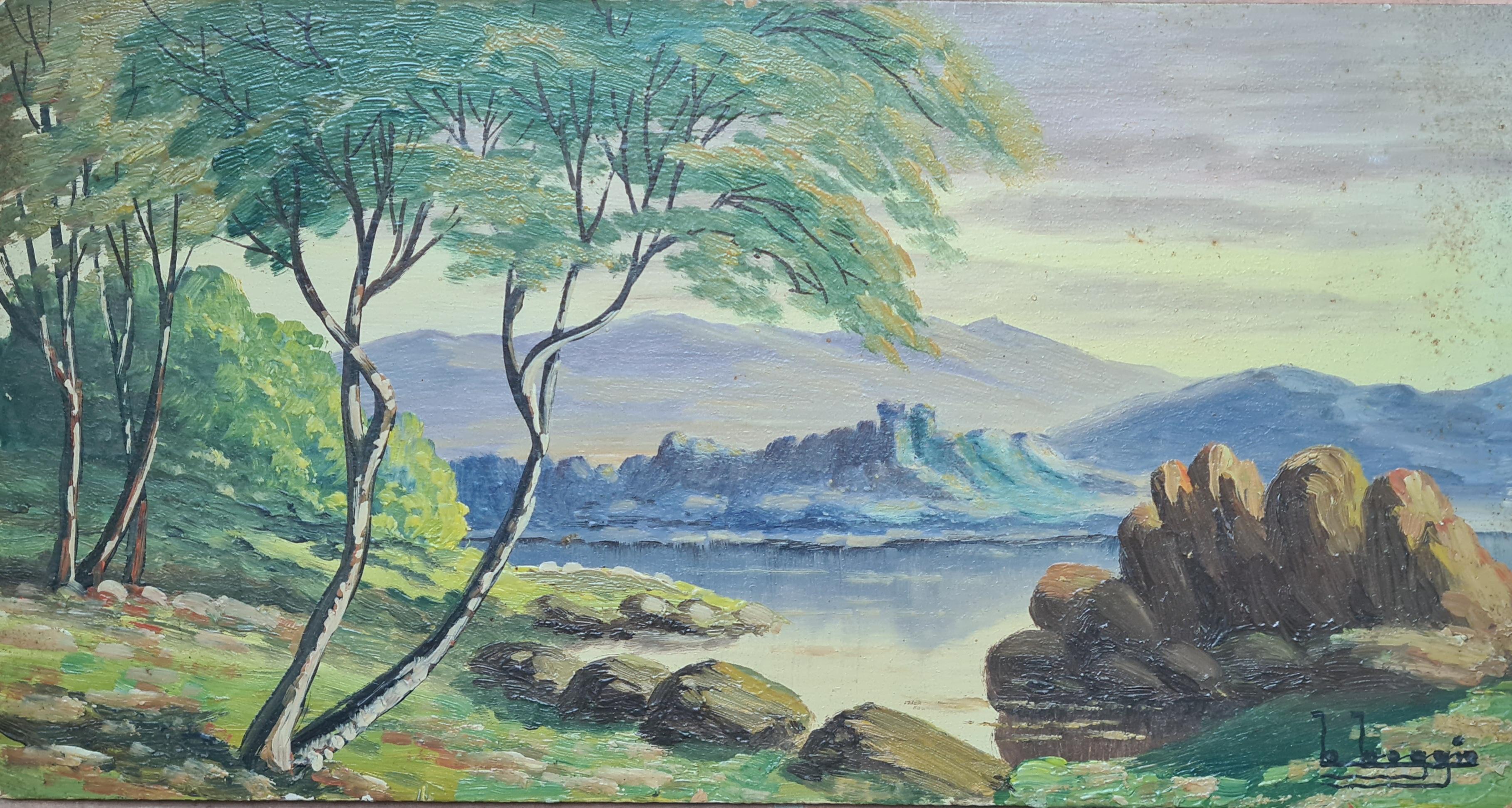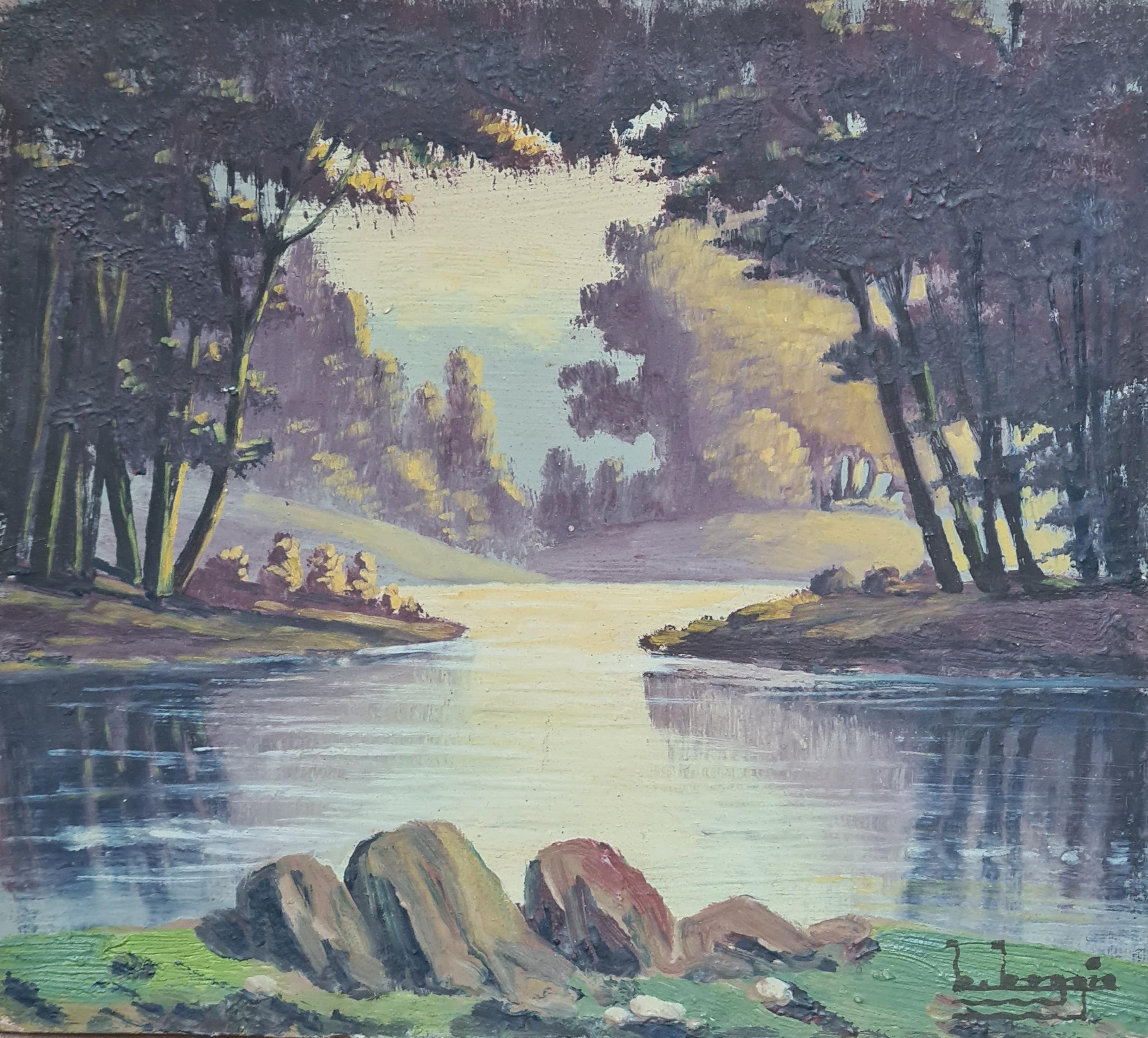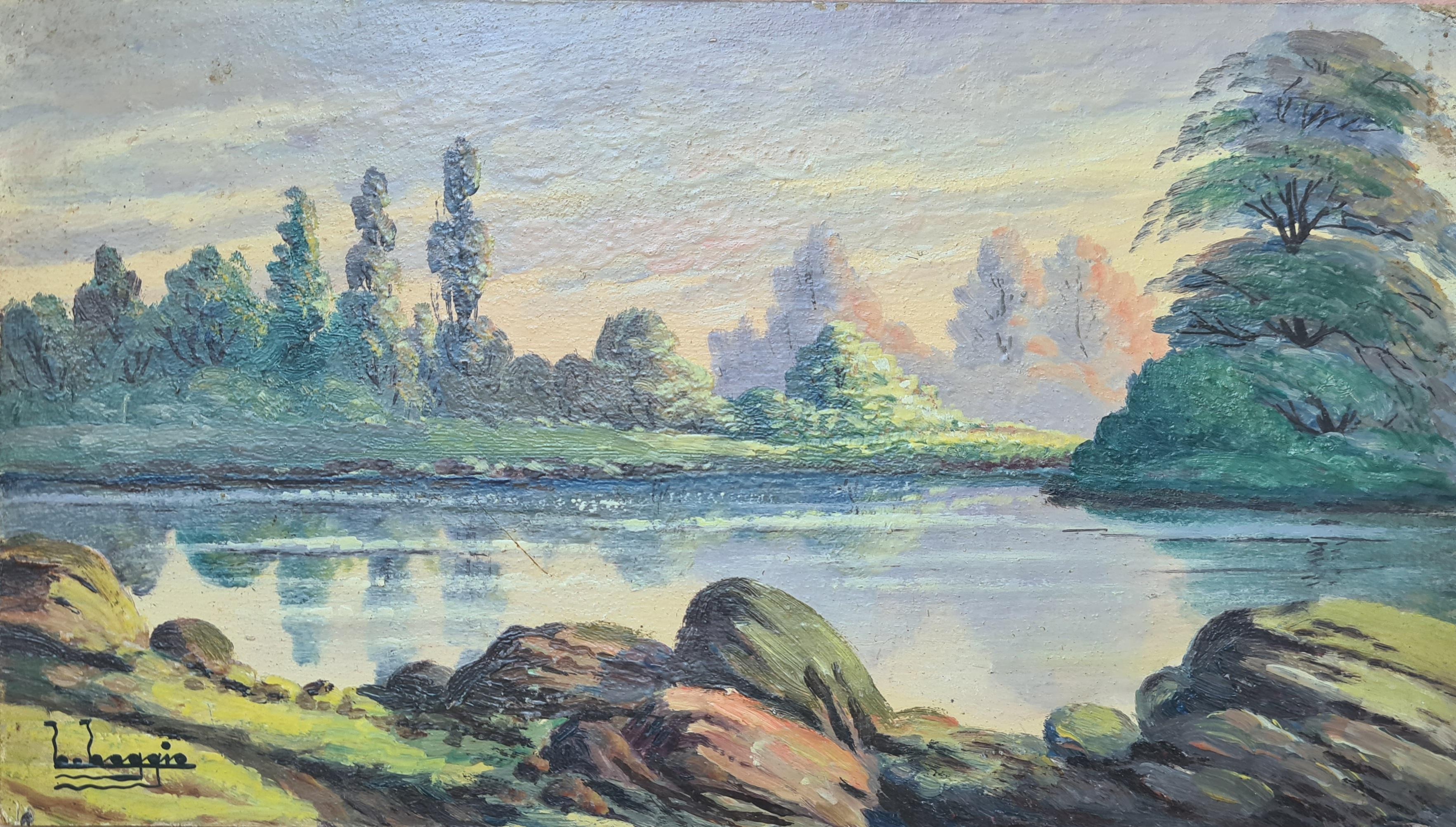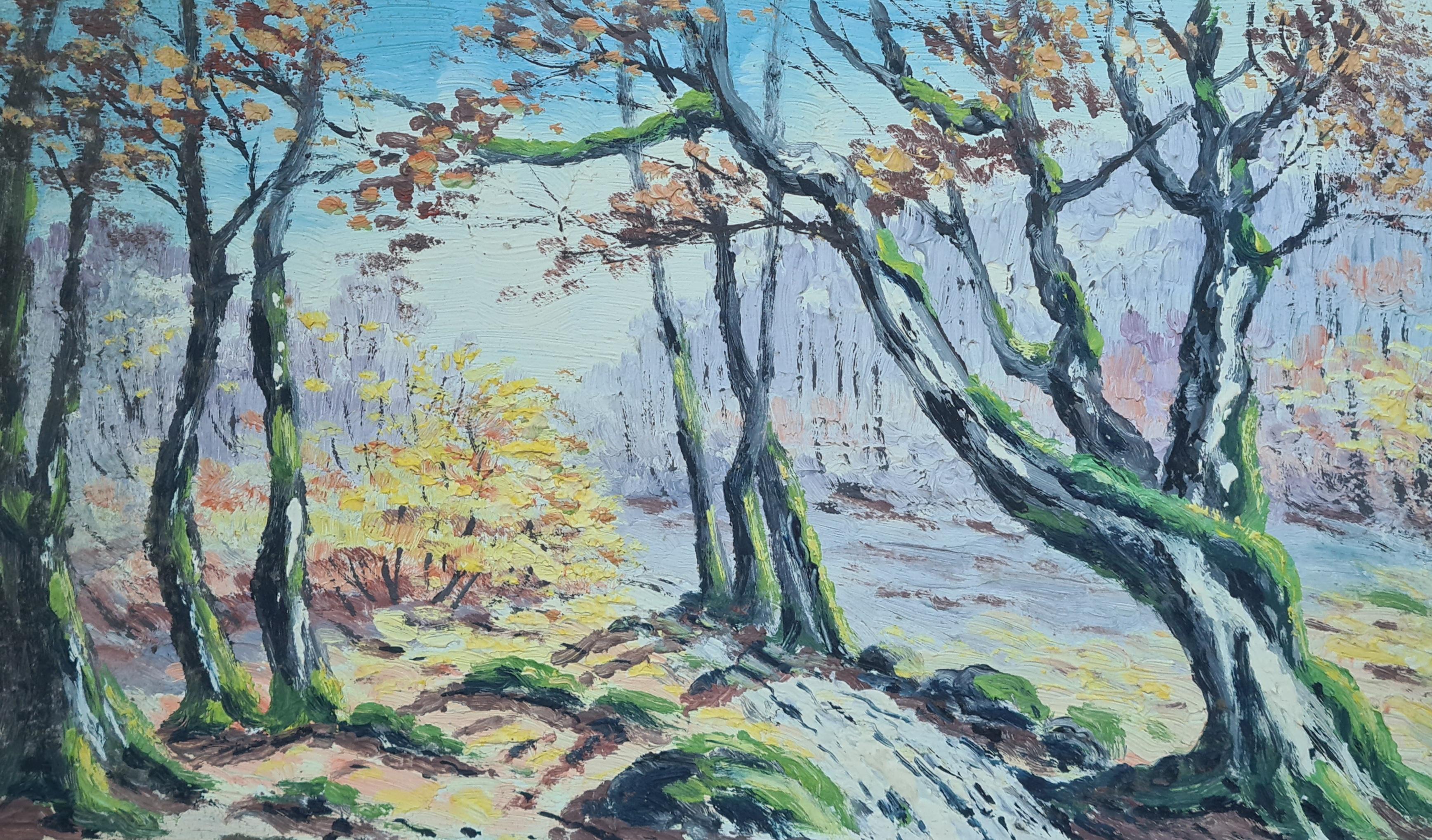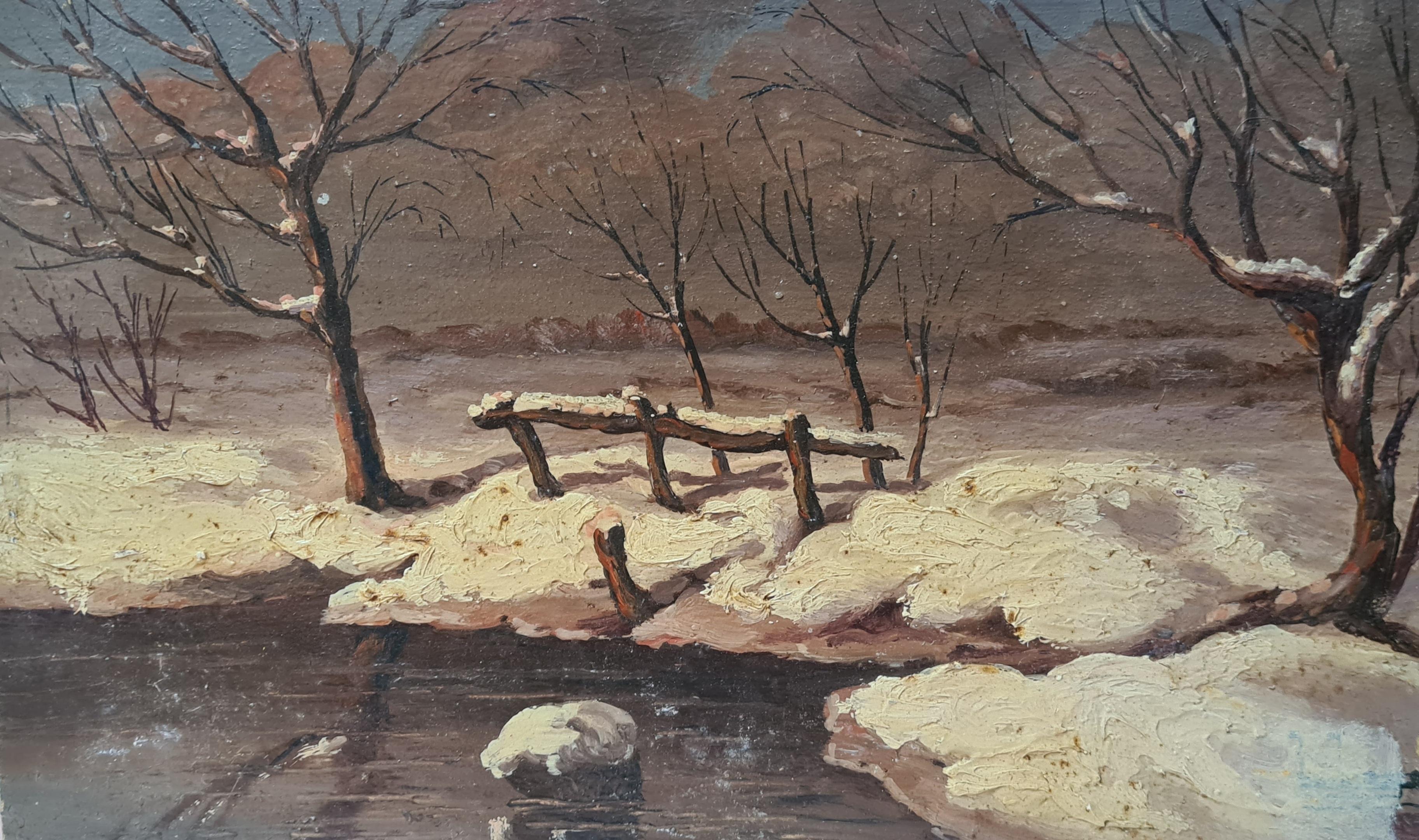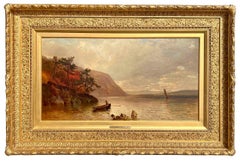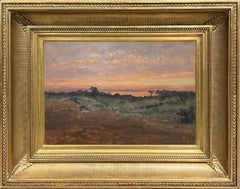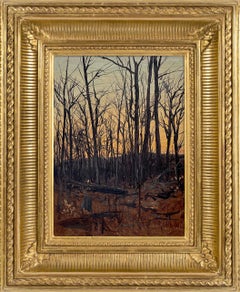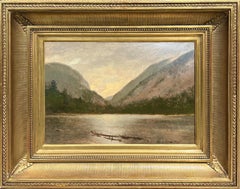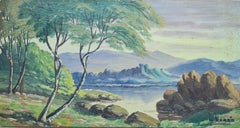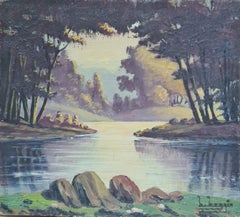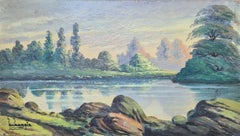Items Similar to Landscape with White Birch by Agnes Bartlett Brown (American, 1847-1932)
Want more images or videos?
Request additional images or videos from the seller
1 of 9
Agnes Bartlett BrownLandscape with White Birch by Agnes Bartlett Brown (American, 1847-1932)
About the Item
"Landscape with White Birch," is a pastoral New England Landscape painted in the Barbizon style by historic woman artist Agnes Bartlett Brown (American, 1847-1932). Painted in oil on board the painting measures 13.63 x 10.25 inches, and is signed on the verso. The work is framed in an elegant, period appropriate frame and is ready to hang.
Agnes Brown and her husband, the landscape painter John Appleton Brown (1844-1902), made a formidable artistic pair. The two traveled and painted together constantly, beginning in 1874 with an extended trip to France where they were exposed to the Barbizon painting of Camille Corot (1796-1875) and his contemporaries. The couple returned to the United States the following year, where they settled in
Boston. In the company of such American Barbizon painters as William Morris Hunt and Joseph Foxcroft Cole, the Browns honed their pastoral renderings of the New England landscape.
As the wife of a well-respected painter, Agnes Brown benefited from her husband’s reputation, encouragement, and lifestyle. However these same privileges tend to obfuscate Agnes Brown’s independent legacy in the historical record as a painter in her own right. While Agnes Brown is rarely considered outside of the context of her husband, however, her paintings retain significant authority on their own. Landscape with White Birch, for example, carries weight as a stand-alone vignette. In Brown’s choice of an arched frame and use of expressive brush strokes to render surprising detail, this pastoral summer scene of a New England landscape ranks among those of her husband and other predominantly male members of the American Barbizon school.
- Creator:Agnes Bartlett Brown (1847 - 1932, American)
- Dimensions:Height: 13.63 in (34.63 cm)Width: 10.25 in (26.04 cm)
- Medium:
- Movement & Style:
- Period:
- Condition:
- Gallery Location:New York, NY
- Reference Number:1stDibs: LU2151214819142
About the Seller
5.0
Recognized Seller
These prestigious sellers are industry leaders and represent the highest echelon for item quality and design.
Established in 2004
1stDibs seller since 2022
5 sales on 1stDibs
- ShippingRetrieving quote...Shipping from: New York, NY
- Return Policy
Authenticity Guarantee
In the unlikely event there’s an issue with an item’s authenticity, contact us within 1 year for a full refund. DetailsMoney-Back Guarantee
If your item is not as described, is damaged in transit, or does not arrive, contact us within 7 days for a full refund. Details24-Hour Cancellation
You have a 24-hour grace period in which to reconsider your purchase, with no questions asked.Vetted Professional Sellers
Our world-class sellers must adhere to strict standards for service and quality, maintaining the integrity of our listings.Price-Match Guarantee
If you find that a seller listed the same item for a lower price elsewhere, we’ll match it.Trusted Global Delivery
Our best-in-class carrier network provides specialized shipping options worldwide, including custom delivery.More From This Seller
View AllAutumn on the Hudson River by Arthur Parton (American, 1842-1914)
By Arthur Parton
Located in New York, NY
"Autumn on the Hudson River" by Hudson River School painter Arthur Parton (American, 1842-1914) is oil on canvas mounted to board. The painting measures 18 1/8 x 34 1/16 inches, and ...
Category
19th Century Hudson River School Landscape Paintings
Materials
Canvas, Oil, Board
New England Sunrise, 1910 by Lockwood DeForest (American, 1850-1932)
Located in New York, NY
"New England Sunrise," 1910 by Hudson River School painter Lockwood DeForest (American, 1850-1932) is oil on artists card-stock and measures 9.75 x 14 inches. The work is signed by DeForest and dated Sept. 17, 1910 at lower left. The work is framed in an elegant, period appropriate frame, and ready to hang.
Lockwood de Forest was born in New York in 1850 to a prominent family. He grew up in Greenwich Village and on Long Island at the family summer estate in Cold Spring Harbor. As was customary for a cultivated family in the Gilded Age, the de Forests made frequent trips abroad. Excursions to the great museums, which were prominent on the de Forests agenda, deepened the young Lockwood's familiarity with European painting and sculpture. Though he had begun drawing and painting somewhat earlier, it was during a visit to Rome in 1868 that nineteen-year-old de Forest first began to study art seriously, taking painting lessons from the Italian landscapist Hermann David Salomon Corrodi (1844–1905). More importantly, on the same trip, Lockwood met one of America’s most celebrated painters, (and his maternal great-
uncle by marriage) Frederic Edwin Church (1826–1900), who quickly became his mentor. DeForest accompanied Church on sketching trips around Italy and continued this practice when they both returned to America in 1869. Early on in his career, de Forest made a habit of recording the date and often the place of his oil sketches, as to create a visual diary of his travels. Lockwood’s profession as a landscape painter can be primarily attributed to Frederic E. Church and his belief in the young artist’s talent.
De Forest often visited Church in the Hudson River community of Catskill where, in addition to sketching trips and afternoons of painting, he assisted with the architectural drawings and planning of Olana. In 1872, de Forest took a studio at the Tenth Street Studio Building in New York. During these formative years de Forest counted among his friend’s artists such as Sanford Robinson Gifford (1823–80), George Henry Yewell (1830–1923), John Frederick Kensett (1816–72), Jervis McEntee (1828–91), and Walter Launt Palmer (1854–1932).
Over the next decade de Forest experienced success as a painter. He exhibited for the first time at the National Academy of Design in 1872, and made two more painting trips abroad, in 1875–76 and 1877–78, traveling to the major continental capitals but also the Middle East and North Africa. His trip to the Middle East and the library at Church’s home, Olana, established his interest in design during his mid-twenties. From about 1878 to 1902, landscape painting was overshadowed by his activities and preoccupation with East Indian architecture and décor, a style that became quite fashionable in late nineteenth century America. From 1879-1883, de Forest founded Associated Artists along with Louis Comfort Tiffany, Candace Wheeler...
Category
Early 20th Century Hudson River School Landscape Paintings
Materials
Oil, Board
Dusk Forest Scene, Catskills by Lockwood DeForest (American, 1850-1932)
Located in New York, NY
"Dusk Forest Scene, Catskills," 1875 by Hudson River School painter Lockwood DeForest (American, 1850-1932) is oil on artists card-stock and measures 9.5 x 7 inches. The work is signed by DeForest, and dated May 13, 1875 at lower right. The work is framed in an elegant, period appropriate frame, and ready to hang.
Lockwood de Forest was born in New York in 1850 to a prominent family. He grew up in Greenwich Village and on Long Island at the family summer estate in Cold Spring Harbor. As was customary for a cultivated family in the Gilded Age, the de Forests made frequent trips abroad. Excursions to the great museums, which were prominent on the de Forests agenda, deepened the young Lockwood's familiarity with European painting and sculpture. Though he had begun drawing and painting somewhat earlier, it was during a visit to Rome in 1868 that nineteen-year-old de Forest first began to study art seriously, taking painting lessons from the Italian landscapist Hermann David Salomon Corrodi (1844–1905). More importantly, on the same trip, Lockwood met one of America’s most celebrated painters, (and his maternal great-
uncle by marriage) Frederic Edwin Church (1826–1900), who quickly became his mentor. DeForest accompanied Church on sketching trips around Italy and continued this practice when they both returned to America in 1869. Early on in his career, de Forest made a habit of recording the date and often the place of his oil sketches, as to create a visual diary of his travels. Lockwood’s profession as a landscape painter can be primarily attributed to Frederic E. Church and his belief in the young artist’s talent.
De Forest often visited Church in the Hudson River community of Catskill where, in addition to sketching trips and afternoons of painting, he assisted with the architectural drawings and planning of Olana. In 1872, de Forest took a studio at the Tenth Street Studio Building in New York. During these formative years de Forest counted among his friend’s artists such as Sanford Robinson Gifford (1823–80), George Henry Yewell (1830–1923), John Frederick Kensett (1816–72), Jervis McEntee (1828–91), and Walter Launt Palmer (1854–1932).
Over the next decade de Forest experienced success as a painter. He exhibited for the first time at the National Academy of Design in 1872, and made two more painting trips abroad, in 1875–76 and 1877–78, traveling to the major continental capitals but also the Middle East and North Africa. His trip to the Middle East and the library at Church’s home, Olana, established his interest in design during his mid-twenties. From about 1878 to 1902, landscape painting was overshadowed by his activities and preoccupation with East Indian architecture and décor, a style that became quite fashionable in late nineteenth century America. From 1879-1883, de Forest founded Associated Artists along with Louis Comfort Tiffany, Candace Wheeler...
Category
19th Century Hudson River School Landscape Paintings
Materials
Oil, Board
Hudson Highlands by Lockwood DeForest (American, 1850-1932)
Located in New York, NY
"Hudson Highlands," by Hudson River School painter Lockwood DeForest (American, 1850-1932) is oil on artists card-stock and measures 9.5 x 14 inches. The work is framed in an elegant, period appropriate frame, and ready to hang.
Lockwood de Forest was born in New York in 1850 to a prominent family. He grew up in Greenwich Village and on Long Island at the family summer estate in Cold Spring Harbor. As was customary for a cultivated family in the Gilded Age, the de Forests made frequent trips abroad. Excursions to the great museums, which were prominent on the de Forests agenda, deepened the young Lockwood's familiarity with European painting and sculpture. Though he had begun drawing and painting somewhat earlier, it was during a visit to Rome in 1868 that nineteen-year-old de Forest first began to study art seriously, taking painting lessons from the Italian landscapist Hermann David Salomon Corrodi (1844–1905). More importantly, on the same trip, Lockwood met one of America’s most celebrated painters, (and his maternal great-
uncle by marriage) Frederic Edwin Church (1826–1900), who quickly became his mentor. DeForest accompanied Church on sketching trips around Italy and continued this practice when they both returned to America in 1869. Early on in his career, de Forest made a habit of recording the date and often the place of his oil sketches, as to create a visual diary of his travels. Lockwood’s profession as a landscape painter can be primarily attributed to Frederic E. Church and his belief in the young artist’s talent.
De Forest often visited Church in the Hudson River community of Catskill where, in addition to sketching trips and afternoons of painting, he assisted with the architectural drawings and planning of Olana. In 1872, de Forest took a studio at the Tenth Street Studio Building in New York. During these formative years de Forest counted among his friend’s artists such as Sanford Robinson Gifford (1823–80), George Henry Yewell (1830–1923), John Frederick Kensett (1816–72), Jervis McEntee (1828–91), and Walter Launt Palmer (1854–1932).
Over the next decade de Forest experienced success as a painter. He exhibited for the first time at the National Academy of Design in 1872, and made two more painting trips abroad, in 1875–76 and 1877–78, traveling to the major continental capitals but also the Middle East and North Africa. His trip to the Middle East and the library at Church’s home, Olana, established his interest in design during his mid-twenties. From about 1878 to 1902, landscape painting was overshadowed by his activities and preoccupation with East Indian architecture and décor, a style that became quite fashionable in late nineteenth century America. From 1879-1883, de Forest founded Associated Artists along with Louis Comfort Tiffany, Candace Wheeler...
Category
19th Century Hudson River School Landscape Paintings
Materials
Oil, Board
Cattle by the Sea, c. 1867 by Ann Sophia Towne Darrah (American, 1819-1881)
Located in New York, NY
"Cattle by the Sea," c. 1867 by historic woman artist Ann Sophia Towne Darrah (American, 1819-1881) was exhibited at the Pennsylvania Academy of the Fine Arts in 1867. Painted in oil...
Category
19th Century Hudson River School Landscape Paintings
Materials
Oil, Canvas
Hudson River Landscape by American Artist Johann Hermann Carmiencke (1810-1867)
By Johann Hermann Carmiencke
Located in New York, NY
Painted by Hudson River School artist Johann Hermann Carmiencke, "Hudson River Landscape" is oil on canvas and measures 12 x 18 inches. The painting is signed and dated 1865 at the l...
Category
19th Century Hudson River School Landscape Paintings
Materials
Canvas, Oil
You May Also Like
Spanish school landscape with river oil painting Spain
Located in Barcelona, Barcelona
Oil on canvas glued to board.
Oil measures 25x40 cm.
Frameless.
Illegible signature.
Category
1920s Barbizon School Landscape Paintings
Materials
Board, Oil, Canvas
$419 Sale Price
55% Off
Barbizon School Lakeside Landscape With Castle. Oil on Board.
Located in Cotignac, FR
An oil on panel idyllic landscape by Boggio. The painting is signed bottom right.
An idealised lakeside landscape view with a castle in the distance in the style of the Barbizon sch...
Category
Mid-20th Century Barbizon School Landscape Paintings
Materials
Oil, Board
Barbizon School Lakeside Landscape, The Shady Glen. Oil on Board.
Located in Cotignac, FR
An oil on panel idyllic landscape by Boggio. The painting is signed bottom right.
An idealised lakeside landscape view of a shady glen in the style of the Barbizon school.
Category
Mid-20th Century Barbizon School Landscape Paintings
Materials
Oil, Board
Barbizon Lakeside Landscape With Poplar Trees. Oil on Board.
Located in Cotignac, FR
An oil on panel idyllic landscape by Boggio. The painting is signed bottom left.
An idealised lakeside landscape view with poplar trees in the style of the Barbizon school.
Category
Mid-20th Century Barbizon School Landscape Paintings
Materials
Oil, Board
A Christmas Winter Wonderland, Barbizon School Snowscape.
Located in Cotignac, FR
An oil on panel view of a winter snow scene by Boggio. The painting is signed bottom right.
A charming view of a snow scene, a river running under a bridge heavy with snow. A Christ...
Category
Mid-20th Century Barbizon School Landscape Paintings
Materials
Oil, Board
Barbizon School Forest Landscape. Oil on Board.
Located in Cotignac, FR
An oil on panel idyllic forest landscape by Boggio. The painting is not signed but was acquired from the artists atelier with other works also listed here on 1stDibs.
An idealised f...
Category
Mid-20th Century Barbizon School Landscape Paintings
Materials
Oil, Board
Recently Viewed
View AllMore Ways To Browse
William Morris Antique
William Bartlett
Amanda Mcpaul
Anna Widmer On Sale
Anthony Wyatt
Antonio Murado
Arkhip Ivanovich Kuindzhi
Art Dumay
Arthur Friedenson
Arthur Vidal Diehl
Asher Benjamin Studio
Benito Quinquela Martin
Benjamin Haughton
Bernhard Klene
Berthe Sourdillon
Betty Rhodes
Blendon Campbell
Blondelle Octavia Malone
